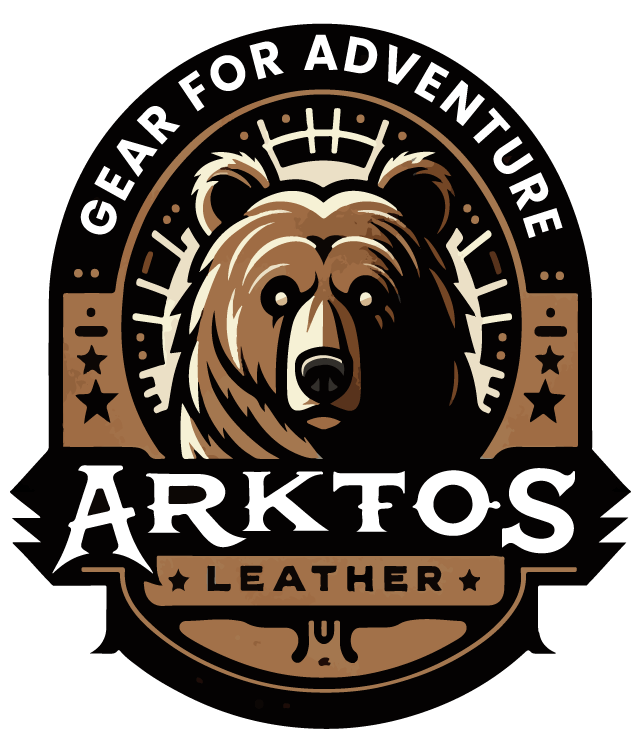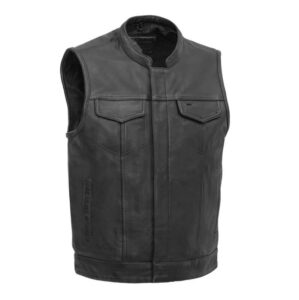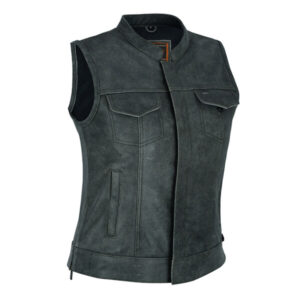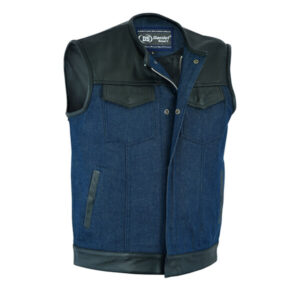Biker culture has a long and illustrious history that is richly entwined with fashion, individuality, and practicality. The leather vest is one of the most recognizable items that a biker should have in their closet. On the other hand, when did this custom of wearing vests first come into existence? Explore the origins, meaning, and evolution of this essential item of biker clothing as we go deeply into the history of biker vests so that we can better understand their significance.
Mens Black Leather SOA Anarchy Outlaw Biker Vest
The Beginnings of Motorcycle Vests
Early Days of Motorcycle Riding (1900s-1940s)
It wasn’t until after World War II that the current biker culture started to take shape, despite the fact that riding motorcycles became popular in the early 20th century. During this time period, a great number of veterans went back to their homes in search of excitement and companionship on the open road. As time went on, the motorbike evolved into a symbol of liberation and defiance. On the other hand, motorcycle riders did not initially wear vests; rather, they mostly wore leather jackets as a means of protecting themselves from road rash and the harsh elements.
Implications of Wearing Military Uniforms
It was the military clothes that troops wore during World War II that had a significant impact on the clothing that bikers wore. A great number of soldiers who had returned from their service were accustomed to wearing vests and insignias that represented their ranks and battalions. It was around this time that this practice made its way into the world of bikers, who were trying to establish their own sense of identity by becoming members of motorcycle clubs and demonstrating their commitment.
Women’s Premium Single Back Panel Gray Concealment Vest
The Rise of Biker Gangs and Motorcycle Clubs (1950s)
At the beginning of the 1950s, motorcycle clubs were beginning to become more prevalent and organized. The Hells Angels, which was established in 1948, along with other early motorcycle groups, had a significant role in the widespread adoption of the biker vest. Vests made of leather or denim vests were chosen by clubs as part of their official dress in order to demonstrate their commitment and solidarity. The term “colours” refers to the back of the vest, which was used as a canvas for patches that featured the name of the club, its logo, and the rank of the individual.
Multiple functions were performed by motorcycle vests:
- Identity: When they were out on the road, members of the club were able to immediately recognize one another.
- Protection: Although a vest did not offer the same level of protection as a full jacket, it did allow for some degree of protection against the elements.
- Pride and belonging: The patches that were stitched into the vest expressed a sense of pride and belonging by demonstrating loyalty to a particular club. These patches were similar to military insignias.
Women’s Lightweight Stylish Motorcycle Leather Vest
The Evolution of Biker Vests in the 1960s and 1970s
Personalization and alteration of the product
A growth in the popularity of personalized motorcycle vests occurred during the 1960s and 1970s. This was due to the fact that club members began adorning their vests with patches that represented their own experiences, values, and individual narratives. Frequently, cyclists added:
- The club that they were a member of was represented by the patch.
- Their position inside the club is denoted by the rank patches they wear.
- Patches that represent the state or chapter of their club are an example of location patches.
- The symbols of outlaws are a representation of their opposition to the norms of normal society.
Among motorcyclists, the vest evolved into more than just an article of clothing; it became a badge of honor and a symbol of freedom, rebellion, and brotherhood among the motorcycle community. Vests made of denim, which offered a lighter alternative to leather and allowed for more intricate patchwork, also began to gain favor during this time period.
Men’s Removable Hood Naked Cowhide Vest w/ Concealed Carry
Pop Culture’s Influence on Things
The public’s perception of the vest-wearing biker was solidified as a result of the proliferation of biker films such as “The Wild One” (1953), which starred Marlon Brando, as well as other films that depicted the culture of bikers. A third factor that contributed to the widespread awareness of the iconic leather biker vest was the growth of counterculture groups during this time period. These movements were connected with the principles of independence and rebellion that bikers held.
The Symbolism of Biker Vest
Patches and Colors
There is no such thing as a complete biker’s vest without its patches, which are imbued with profound importance. When it comes to the “colours” on the back, a three-piece patch is frequently used:
- The name of the club is displayed on the top rocker.
- “Club emblem” refers to the primary design, which is typically a logo or symbol.
- The bottom rocker is a display that shows the location of the club or the chapter.
The vest is a potent sign of identification within the biker community since it has these features, in addition to other patches that denote rank or membership status. During the Hollister Riot in 1947, the American Motorcycle Association said that 99% of motorcyclists were law-abiding, leaving the remaining 1% to represent outlaws. Some patches, like as the notorious “1%er” patch, reflect an outlaw biker’s defiance of societal norms. This is a reference to the Hollister Riot.
Men’s SOA Leather Biker Vest W/ USA Flag Lining
Brotherhood and Loyalty
Brotherhood and allegiance to one’s club are both shown by the wearing of a vest. It demonstrates a dedication to the group’s norms, ideals, and traditions that have been established. The right to wear a complete vest is something that new members have to gain, and they typically begin as a “prospect” and eventually demonstrate their allegiance to the organization. Within the culture of bikers, a vest that has been completely patched becomes a symbol of social acceptance and respect.
Biker Vests in the Modern Era
The Popularity of Vests Today
There are still many riders that continue the practice of wearing leather or denim vests that are embellished with patches in the 21st century. Biker vests continue to be an essential part of the culture surrounding motorcycles. The vest, on the other hand, is no longer restricted to members of extreme motorcycle groups. Vests are worn by even casual riders in today’s world as a means of expressing their individual sense of style and connecting with the lengthy history of the culture of bikers.
Men’s Leather/Denim Combo Biker Vest Blue
Beyond the Motorcycle Clubs
Beyond the realm of motorcycle clubs, vests have made their way into mainstream fashion and are frequently worn by enthusiasts who may not be members of a club but who nonetheless identify with the independence and rebellious spirit of the biker lifestyle. Some of the events, festivals, and rallies that are associated with motorcycles include the Sturgis Motorcycle Rally and Daytona Bike Week. Biker vests are also available at these events.
The Biker Vest’s Enduring Legacy and Its Implications for the Future
Throughout the years, the biker vest has seen a tremendous transformation, beginning with its humble beginnings as clothing inspired by the military and eventually reaching its iconic stature within motorcycle clubs and the larger culture of bikers. It continues to be a potent sign of identification, camaraderie, and defiance, and it perfectly encapsulates the spirit of what it means to be described as a biker. There will always be a connection between the biker vest and the values of tradition and brotherhood, despite the fact that its meaning and style will continue to change as the culture continues to develop.






